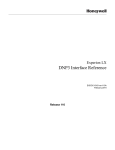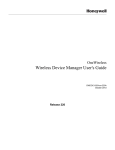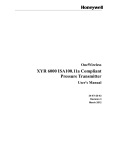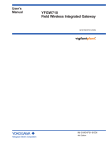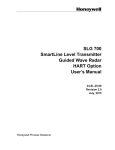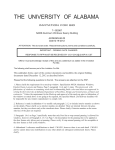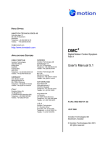Download Field Device Access Point User`s Guide
Transcript
OneWireless Field Device Access Point User's Guide OWDOC-X256-en-220A October 2013 Release 220 Document Release Issue Date OWDOC-X256-en-220A 220 0 October 2013 Disclaimer This document contains Honeywell proprietary information. Information contained herein is to be used solely for the purpose submitted, and no part of this document or its contents shall be reproduced, published, or disclosed to a third party without the express permission of Honeywell International Sarl. While this information is presented in good faith and believed to be accurate, Honeywell disclaims the implied warranties of merchantability and fitness for a purpose and makes no express warranties except as may be stated in its written agreement with and for its customer. In no event is Honeywell liable to anyone for any direct, special, or consequential damages. The information and specifications in this document are subject to change without notice. Copyright 2013 - Honeywell International Sarl 2 www.honeywell.com Contents 1 About this guide ..................................................................................................................................... 5 2 Introduction to FDAP ............................................................................................................................. 7 2.1 2.2 2.3 2.4 2.5 2.6 FDAP description ............................................................................................................................................... 8 Types of FDAPs ................................................................................................................................................ 10 Physical description of FDAP ........................................................................................................................... 11 Features of FDAP ............................................................................................................................................. 13 FDAP security .................................................................................................................................................. 14 FDAP technical specification and compliance information ............................................................................. 15 3 FDAP Installation .................................................................................................................................. 17 3.1 3.2 3.3 3.4 3.5 3.6 Prerequisites for installation ............................................................................................................................. 18 Inspect FDAP and associated hardware ........................................................................................................... 19 Identify FDAP site locations ............................................................................................................................ 20 Connect antennas .............................................................................................................................................. 21 Ground the FDAP ............................................................................................................................................. 23 Mount the FDAP .............................................................................................................................................. 24 3.6.1 Pole mounting .................................................................................................................................... 24 3.6.2 Wall or flat surface mounting ............................................................................................................ 25 3.7 Connect power cables and Ethernet cables ....................................................................................................... 26 3.7.1 DC power wiring ............................................................................................................................... 26 3.7.2 AC power wiring ............................................................................................................................... 27 3.7.3 Ethernet wiring .................................................................................................................................. 27 3.8 Power on and startup ........................................................................................................................................ 30 4 FDAP Configuration ............................................................................................................................. 31 4.1 Establish connection between WDM and FDAP .............................................................................................. 32 4.2 Provision an FDAP ........................................................................................................................................... 33 4.3 Description of FDAP parameters ...................................................................................................................... 34 5 FDAP Monitoring .................................................................................................................................. 41 5.1 5.2 5.3 5.4 5.5 Overview about monitoring .............................................................................................................................. Verify connectivity using maps ........................................................................................................................ Monitor using Provisioning Device handheld .................................................................................................. Monitor using events ........................................................................................................................................ Monitor using reports ....................................................................................................................................... 42 43 44 45 46 6 FDAP Maintenance and Troubleshooting .......................................................................................... 47 6.1 6.2 6.3 6.4 Replace an FDAP ............................................................................................................................................. Remove an FDAP ............................................................................................................................................. Upgrade an FDAP firmware ............................................................................................................................. Troubleshoot an FDAP ..................................................................................................................................... 48 49 50 51 7 Notices .................................................................................................................................................. 53 7.1 Documentation feedback .................................................................................................................................. 54 7.2 How to report a security vulnerability .............................................................................................................. 55 3 CONTENTS 4 www.honeywell.com 1 About this guide This document describes the procedures to install, configure, and operate the Field Device Access Point (FDAP). FDAP is one of the components in the OneWireless Network solution for industrial control. Intended audience This guide is intended for people who are responsible for planning, administering, and operating the OneWireless Network. These people include Plant Managers, Process Engineers, and System Administrators. Prerequisite skills It is assumed that you are familiar with the operation of OneWireless Network, Experion system software, and the plant processes which Experion controls, Microsoft Windows operating systems, and network administration tasks. How to use this guide This guide provides guidance on: • • • • • FDAP description FDAP installation FDAP configuration FDAP monitoring FDAP maintenance and troubleshooting Required Honeywell documentation The following documents and sources contain additional information required for deploying OneWireless Network. It is recommended to have these documents readily available for reference. Document Document ID Description OneWireless Network Planning and Installation Guide OWDOC-X253-en-220A This document provides information about planning, designing, and setting up the OneWireless Network using WDM, FDAPs, and field devices. OneWireless WDM User’s Guide OWDOC-X254-en-220A This document describes the procedures to provision, configure, operate, and monitor an ISA100 Wireless wireless field device network using Wireless Device Manager (WDM). 5 1 ABOUT THIS GUIDE Document Document ID Description OneWireless Wireless LAN Controller Configuration Guide OWDOC-X255-en-220A This document provides information about planning, designing, setting up, and configuring a OneWireless Network using WDM, FDAPs, Cisco 1552S APs, and field devices. FDAP Regulatory Compliance Guide — This document describes the FDAP Regulatory Compliance information. OneWireless Parameter Reference Dictionary OWDOC-X260-en-220A This document provides information about the parameters associated with OneWireless devices. You can download Honeywell documentation from http://www.honeywellprocess.com web site. 6 www.honeywell.com 2 Introduction to FDAP Related topics “FDAP description” on page 8 “Types of FDAPs” on page 10 “Physical description of FDAP” on page 11 “Features of FDAP” on page 13 “FDAP security” on page 14 “FDAP technical specification and compliance information” on page 15 7 2 INTRODUCTION TO FDAP 2.1 FDAP description The Field Device Access Point (FDAP) is a ruggedized industrial radio device intended for use in hazardous location to provide wireless connectivity for ISA100 Wireless compatible field devices. As an industrial meshing access point, FDAP provides secure and reliable wireless coverage for ISA100 Wireless field devices. It also serves as a routing access point for ISA100 Wireless field devices and is located between the wired DCS network and ISA100 Wireless-based wireless field devices. Once deployed in the field, FDAPs self-discover and self-organize into a managed, secure, and redundant wireless field device mesh network. With FDAPs, wireless field devices do not have to route data from other field devices. The following figure illustrates how FDAPs are used in a OneWireless Network: Figure 1: OneWireless Network FDAP uses IEEE 802.15.4 standard based radio technology and combines spatial diversity with advanced error correction schemes to communicate in a complex multi-path environment and in large communication areas. It has an Ethernet interface for connection to the backbone network and an ISA100 Wireless compliant radio to connect to the wireless field device network. It is a standalone, pole mountable, intrinsically-safe device, suitable for use in hazardous locations. It is normally installed in the same area where industrial field devices are installed. FDAP supports 10/100 Mbps Fast Ethernet and has spatial antenna diversity. Table 1: FDAP models 8 Access Point type Model numbers Power options Suitable for… FDAP certified for Class I Division 1, Zone 0/1 Areas FDAP1 18 - 24VDC Intrinsic Safety (IS) source for Class I Division 1, Zone 0/1 applications www.honeywell.com 2 INTRODUCTION TO FDAP Access Point type Model numbers Power options Suitable for… FDAP certified for Class I Division 2, Zone 2 Areas FDAP2 120/230 VAC Class I Division 2, Zone 2 and general purpose applications 18 - 24VDC 9 2 INTRODUCTION TO FDAP 2.2 Types of FDAPs Standalone FDAP A standalone FDAP has a radio board and an autonomous power subsystem that operates within a range of AC/DC inputs. Standalone FDAP supports ISA100 Wireless-based radio communication, and it does not support Wi-Fi or other radio technologies. The standalone FDAP may be used for Class I Division 1, Zone 0/1 applications that require IS protection methods and design technique or Class I Division 2, Zone 2 and general purpose applications. FDAP as field router A standalone FDAP can be used as a Field Router (FR). If FDAP is not connected to the physical Ethernet, it functions as a line powered FR. FDAP as a line powered FR option can be used for extending field mesh into hazardous environments where normal infrastructure nodes are not suitable. 10 www.honeywell.com 2 INTRODUCTION TO FDAP 2.3 Physical description of FDAP FDAP enclosure The FDAP has a rugged die-cast aluminum enclosure for outdoor use. The enclosure and all auxiliary components are designed to meet IP66 and NEMA Type 4X ratings for protection against dust and water ingress. The enclosure has two water-tight type N bulkhead connectors for antenna spatial diversity in the FDAP radios. The half-inch rigid conduit hub has a gasket to seal out water and dust. A rigid conduit hub, internal and external ground studs, and a removable cover are provided for field installation. Externally accessible Infrared (IR) port allows the device to be commissioned in the field. Three status LEDs provide information about power, device health, and communication. The enclosure may be mounted on a pole or on a flat surface such as a wall using the available optional mounting brackets. The enclosure measures approximately 20 cm x 13 cm x 7 cm (L x W x H). Figure 2: Physical description of FDAP IR port The FDAP has an externally accessible IR port that is used for communicating with the Provisioning Device handheld. The Provisioning Device handheld is used for commissioning the FDAP, reading, and setting the various FDAP parameters. The IR port has a range of 20 cm and a beam width of 20 degrees. FDAP communication radio FDAP has ISA100 Wireless compliant radios that operate in the 2.4 GHz ISM band. It uses spatial antenna diversity with sophisticated error correction schemes to improve communication and increase coverage in a typical industrial complex where multi-path propagation is prevalent. 11 2 INTRODUCTION TO FDAP Antennas FDAP uses dual antenna diversity to improve communication reliability in severe multi-path environment. This helps in improving radio coverage and provides robust communication links thereby reducing infrastructure cost and cost per wireless field device. FDAP has integral omni-directional antennas and it also supports a variety of high- and low-gain directional and omni-directional antennas to provide flexibility in installation and to maximize performance of the wireless system. For more information about certified antennas and the allowable maximum RF output power, refer to the FDAP Regulatory Compliance Guide. FDAP has integrated lightning suppressors on the antenna ports. The lightning suppressors are permanently attached and do not require field maintenance. Lighting suppressors are required for all outdoor installations or indoor installations where FDAP may be subjected to lightning surge. Optional remote mounted lightning suppressors are available for use in application where the remote antenna cable is exposed to lightning surge. LED indicators FDAP has three LEDs for indicating the status and health of the device. For more information about LEDs, refer to “Table 3: LED indicators”. 12 www.honeywell.com 2 INTRODUCTION TO FDAP 2.4 Features of FDAP The features of FDAP are as follows: • 24 VDC or 120/230 VAC powered: FDAP operates at 24 VDC or 120/230 VAC and provides better latency than battery-based wireless field device mesh network. It enables the use of wireless field devices for applications requiring fast update rates (less than 10 seconds) and short latency (less than 250 ms) and in areas where Wi-Fi radios are not allowed. • Antenna diversity: FDAP uses spatial antenna diversity to improve communication success rates and to improve coverage in multi-path environments. This is necessary for the majority of industrial application where there is no direct line of site between field devices. Antenna diversity significantly improves data availability in such applications. • Fast Ethernet: FDAP has 10/100 Mbps Fast Ethernet interface and can be integrated into any network that supports Ethernet communication. • Field Mesh network: Multiple FDAPs can form a self-forming, self-healing wireless mesh network. This extends the range and coverage of the wireless sensor network and provides redundant communication paths for improved data availability. Unlike battery-power field devices, FDAPs are line powered and so can aggregate data from multiple field devices including other FDAPs without concerns about battery life. • Reduced cost: FDAP reduces wireless field device cost, infrastructure cost, and cost per wireless I/O. It reduces the number of ISA100 Wireless routing devices and offers wireless coverage for ISA100 Wireless field devices. It has lesser installation cost than Access Points for sensor only applications. • Access points: FDAP acts as a routing access point for wireless field devices and it is designed for sensoronly network for monitoring application segment. • IPv6 device: FDAP is an Internet Protocol version 4 (IPv4) device. The IPv4 protocol provides an end-toend data transmission across multiple IP networks. FDAP gets the IP address from DHCP Server in Field Device Network (FDN). You can ping an FDAP from the FDN network. You cannot ping an FDAP from the Plant Control Network (PCN). You cannot ping an FDAP when used as a Router. • Backbone router: FDAP is a backbone router in a rugged industrial enclosure that acts as a bridge between the field device network and wireless backhaul network such as IEEE 802.11 WLAN. 13 2 INTRODUCTION TO FDAP 2.5 FDAP security OneWireless Network protects plant information and ensures safe operations with industry standard 128-bit encryption at the mesh, Wi-Fi, and wireless field device level. The FDAP offers a robust embedded ISA100 Wireless security. FDAP authentication In addition to data encryption, ISA100 Wireless standard requires each FDAP to be authenticated before joining the network. OneWireless Network relies on a more secured IR authentication key distribution method as it requires users to be physically next to the FDAP to add it to the network. The authentication keys are generated and managed by the WDM. A Provisioning Device handheld is used to upload the authentication keys from the WDM to Provisioning Device handheld and to download keys to FDAPs using IR media. The IR media is used to send an authentication key from the Provisioning Device handheld to the FDAP. Therefore, all Provisioning Device handhelds and FDAPs have IR ports for device commissioning. The keys are encrypted when distributed over the network. Once a key is deployed to an FDAP, it is validated by the WDM before the FDAP can join the OneWireless Network. Key deployment is a one-time activity, that is, the devices can rejoin the network after power down or after any other service interruptions without re-keying the device. OneWireless supports a key rotation mechanism to enable a secure network. Once the devices join the network, a master key and a session key is assigned to each device, and the session key can be rotated on a periodic basis. The key rotation period can be configured from the OneWireless user interface. For best system performance, it is recommended to set the key rotation period as infinite. In addition, from OneWireless R210 release onwards, over the air provisioning is supported. This allows the FDAPs to join the secure OneWireless Network and establish communication with other devices and the WDM. Embedded ISA100 Wireless security To reduce security threats, ISA100 Wireless requires all process data to be 128-bit encrypted. The data is encrypted at the source and decrypted at the destination to provide end-to-end security for the process data. The FDAPs self-discover other neighboring ISA100 Wireless routing devices, such as Access Points, and routing ISA100 Wireless field devices, to form a reliable and secure ISA100 Wireless based wireless mesh network. Wireless routing algorithm enables an FDAP to dynamically identify the best route to send data to and from wireless field devices. This algorithm enables the field device mesh network to dynamically re-optimize itself when FDAPs are added to or removed from the network. 14 www.honeywell.com 2 INTRODUCTION TO FDAP 2.6 FDAP technical specification and compliance information For information about FDAP technical specification and regulatory compliance information, refer to the OneWireless R200 Field Device Access Point Specifications document available at Honeywell Support Web site. 15 2 INTRODUCTION TO FDAP 16 www.honeywell.com 3 FDAP Installation Related topics “Prerequisites for installation” on page 18 “Inspect FDAP and associated hardware” on page 19 “Identify FDAP site locations” on page 20 “Connect antennas” on page 21 “Ground the FDAP” on page 23 “Mount the FDAP” on page 24 “Connect power cables and Ethernet cables” on page 26 “Power on and startup” on page 30 17 3 FDAP INSTALLATION 3.1 Prerequisites for installation Complete the network planning before installing FDAP. For information about network planning, refer to the Network Planning and Installation Guide. Complete the following tasks before installing the FDAPs in the wireless network. • Network site planning: Complete site planning to understand how a wireless network can be built and supported for your application using OneWireless components. • RF site assessment: Perform an RF site assessment when designing a large wireless network. The site assessment should at a minimum include the following tasks: – Conduct the site assessment when the plant is operating, so that maximum possible interference can be measured and addressed. – Conduct RF spectrum analysis on the 2.40-2.49 GHz band to detect any potential RF interference. Strong interference sources should be addressed (removed, avoided or minimized) before the installation. Note that some frequencies may not be available for use in some locations and countries. – Arrange point-to-point mesh in various locations to measure the RF propagation ability in the site. Received Signal Strength Indicator (RSSI) can serve as an indicator of the RF environment. TCP/IP throughput testing and UDP/IP throughput and packet drop rate testing should be conducted in all selected locations to measure the quality of the signal strength in the site. 18 • FDAP placement: Determine FDAP placement after the completion of the network planning and RF assessment activities. • Power requirements: Identify power requirements for the network. Determine wired cable runs to provide DC power to the FDAP. • Ethernet cable runs: Determine Ethernet cable runs for FDAP and/or any other wired nodes in the network. www.honeywell.com 3 FDAP INSTALLATION 3.2 Inspect FDAP and associated hardware Ensure that all the hardware that are necessary for completing the installation for each FDAP are available. Examine whether the FDAP and the associated hardware like antennas and mounting brackets are damaged. 19 3 FDAP INSTALLATION 3.3 Identify FDAP site locations The location of all FDAPs should be determined to ensure optimum operation in a wireless network. After the completion of network site planning and RF assessment activities, the locations for FDAPs are identified. Locations can be mapped so that the site preparation for FDAPs can be started. For more information about prerequisites, refer to “Prerequisites for installation” on page 18. 20 www.honeywell.com 3 FDAP INSTALLATION 3.4 Connect antennas Antennas play a critical role in the setup and operation of wireless mesh systems. Depending upon the results of the site assessment and the requirements of the installed environment, proper antenna type (omni-directional versus directional, low-gain versus high-gains, and so on) should be determined. The various types of antennas offered with FDAP enhance the wireless coverage of the field devices in multi-path environment. It is recommended to use same antenna type and gain on both antennas for optimum performance. Attention After the antennas are connected, the connections should be sealed to protect them from the external environment. Figure 3: Antenna components 21 3 FDAP INSTALLATION Figure 4: Antenna connections 22 www.honeywell.com 3 FDAP INSTALLATION 3.5 Ground the FDAP The FDAP provides internal and external grounding point to meet various local and regulatory grounding requirements. You should ensure that the FDAPs are grounded properly by a certified and authorized personnel, and that it conforms to all applicable codes and regulations. The materials required to provide a proper ground are defined by local regulations, and should be obtained locally to ensure that the correct safety environment is achieved. 23 3 FDAP INSTALLATION 3.6 Mount the FDAP The assembled FDAP, along with antennas and lightning suppressors (if required) can be mounted in its site location. The FDAP enclosure can be mounted on a 2-inch pole or on a wall using the appropriate optional mounting kit that is available with the unit. 3.6.1 Pole mounting When pole mounting the FDAP, you can assemble and install the mounting hardware at the site. The mounting kit includes the following items: • Mounting plate • U-bolts with nuts • Screws (to attach the FDAP to the mounting plate) The pole mounting kit comprises of mounting plate, U-bolts, and nuts as displayed in “Figure 5: Pole mounting ”. When using the mounting plate for the pole installation, secure the FDAP to the bracket using the screws supplied with the bracket kit. The FDAP can be mounted to the left or to the right of the pole using the same mounting hardware. It can also be mounted inline with the pole. However, if the integral antennas are too close to the pole, it might cause RF communication problem. For inline mounting, the FDAP integral antennas should be on the top of the mounting pole. Figure 5: Pole mounting 24 www.honeywell.com 3 FDAP INSTALLATION 3.6.2 Wall or flat surface mounting The wall mounting kit comprises a wall mounting plate and four screws as displayed in “Figure 6: Wall mounting”. Both mounting plates fasten to four threaded bosses on the back of the FDAP. The FDAP should not be mounted on metallic walls because the integral antennas are too close to the wall and causes RF propagation problems. Figure 6: Wall mounting 25 3 FDAP INSTALLATION 3.7 Connect power cables and Ethernet cables FDAP has one Ethernet cable and one power cable. You have to construct conduit and cable runs for power and Ethernet. The FDAP can be powered directly by universal AC power supply (90 – 240 VAC, 50/60 Hz) or by external 24 VDC power supply such as distributed DC source. Ensure that all wires inside the enclosure are routed and secured properly as displayed in“Figure 7: Ethernet and field DC power” and“Figure 8: Ethernet and field AC power”. The FDAP has integrated terminal blocks that allow field wiring to be directly terminated inside the FDAP without an additional external junction box. Power (both AC and DC) connection, Ethernet and Serial connections can be terminated inside the FDAP. 3.7.1 DC power wiring When powered from an external 24 VDC source, the power cable should be terminated directly onto the twoposition terminal block on the Power Board. The polarity of the connector is marked next to the connector on the Power Board. The power cable should be shielded and the drain wire grounded inside the enclosure as displayed in “Figure 7: Ethernet and field DC power”. Secure all connections and wires and connect the cover-ground connection lug to the enclosure cover to complete the wiring. Figure 7: Ethernet and field DC power Attention For installations that require CE-mark compliance, the DC power source must be a CE-mark approved power supply. In addition, the DC cable between the approved DC power source must be no more than 3.0 meters (9.8 feet) from the FDAP. 26 www.honeywell.com 3 FDAP INSTALLATION 3.7.2 AC power wiring When powered from an external AC source, the power cable should be terminated at the terminal block on the AC/DC conversion module, marked as 24 VDC Power Brick as displayed in “Figure 8: Ethernet and field AC power”. • • • • To facilitate wiring, remove the Power Brick assembly from the enclosure by loosening the two retaining screws and sliding the brick assembly out. Terminate the AC cables at the AC terminal block on the Power Brick module. The module has polarity markings for Live (L), Neutral (N) and Ground. Ensure that all connections are secure and then slide the module back into the enclosure and secure it with the retaining screws. Secure all connections and wires and connect the cover-ground connection lug to the enclosure cover to complete the wiring. Attention If an AC power option is ordered from the factory, the DC output of the power conversion module should be pre-wired to the DC terminal block on the Power Board. Verify that the connection is secure and has the correct polarity as marked. Figure 8: Ethernet and field AC power 3.7.3 Ethernet wiring FDAP has one Ethernet input for optional connection to a wired network or a wireless access point. If the FDAP is connected to a wired Ethernet, you should run the Ethernet cabling from the control system through the 27 3 FDAP INSTALLATION conduit to the FDAP site. You have to install the FDAP based on the Ethernet connection. If Ethernet cable is connected, it acts as an FDAP (access point) and if the Ethernet cable connection is removed it acts as a line powered FR (routing device). An 8-position Insulation Displacement Connector (IDC) terminal block allows twisted pair Ethernet cable to be connected to the FDAP without stripping the wires or crimping on modular RJ-45 plugs. The drain wire from the CAT5E cable shield should be connected to the internal grounding point on the conduit hub. The cable should be solid core to ensure good signal quality and performance of up to 100 m. Terminating the Ethernet cable To terminate the Ethernet cable, perform the following steps. 1. Strip the outer jacket of the CAT5e cable and connect the shield drain wire to the internal grounding lug on the conduit hub. Do not strip the individual twisted pair wires. 2. Connect the twisted pair wires to the IDC following the color chart marked next to the IDC. Note that the color chart on the FDAP Power and I/O board assumes that the cable conforms to EIA/TIA 568B color code which is the predominant color code for CAT5e cable. Refer to “Table 2: Ethernet IDC block pin-out” for the necessary adjustment if the older EIA/TIA 568B color coded cable is used. Most of the CAT5E cables conform to TIA/EIA 568B. Table 2: Ethernet IDC block pin-out PIN # 28 TIA/EIA 568A TIA/EIA 568B Data 1 Transmit+ 2 Transmit- 3 Receive+ 4 Unused 5 Unused 6 Receive- 7 Unused 8 Unused www.honeywell.com 3 FDAP INSTALLATION Testing Ethernet connection A standard RJ-45 modular jack is available on the FDAP Power and IO board. The RJ-45 jack may be used to test cable integrity after terminating the cable at the IDC connector. After terminating the field cable at the IDC, connect the cable tester to the RJ-45 jack. An end-to-end cable test can then be performed to ensure proper wiring at the IDC connector. 29 3 FDAP INSTALLATION 3.8 Power on and startup The FDAP has status LEDs to indicate the various stages of operation. Figure 9: LED indicators The following table identifies the LEDs and describes the operating conditions of the unit when the LEDs are turned ON. Table 3: LED indicators 30 LED Description Power LED (Green) Indicates that the power is supplied to FDAP. When the FDAP is powered ON, Power LED turns ON automatically. Status LED/Heart Beat LED (Green) Indicates the software status of FDAP factory image. The Status LED blinks ON/OFF once every second to indicate that the FDAP factory firmware is in the working condition. Comm LED (Green) Indicates the Ethernet link activity. www.honeywell.com • The LED is steady when there is a valid Ethernet link but no data activity. • The LED blinks when there is data activity on the Ethernet link. 4 FDAP Configuration Related topics “Establish connection between WDM and FDAP” on page 32 “Provision an FDAP” on page 33 “Description of FDAP parameters” on page 34 31 4 FDAP CONFIGURATION 4.1 Establish connection between WDM and FDAP To establish connection between WDMA and FDAP, power on the FDAP and connect FDAP to the WDM through FDN port of WDM. If you are using multiple FDAPs, you can use an Ethernet switch to connect the FDAPs to the WDM. WDM enables you to commission, configure, and monitor the FDAPs connected to it from a centralized location. All FDAP configuration parameters are easily accessible from the WDM, which centralizes all key functions required to manage the field device network and wireless field devices. Log on to the OneWireless user interface and configure the WDM using the First Time Configuration Wizard. The First Time Configuration wizard appears only for the first log on. For more information about First Time Configuration and OneWireless user interface details, refer to the Wireless Device Manager User’s Guide. 32 www.honeywell.com 4 FDAP CONFIGURATION 4.2 Provision an FDAP The FDAP should be given a unique authentication key to associate it with the wireless network in which it is installed and operated. The authentication keys are generated and managed by the WDM. You can provision an FDAP using over-the-air provisioning or using a Provisioning Device handheld. A Provisioning Device handheld is used to upload the authentication keys from the WDM to the Provisioning Device handheld, and then download the keys to FDAPs using IR media. You can send provisioning information (security, wireless) from Provisioning Device handheld to the FDAP using IR communication link. Once the unit is set up and the authentication is completed, the FDAP joins the network and starts communicating. Attention Before provisioning an FDAP, ensure that you have configured the WDM using the First Time Configuration Wizard and the authentication keys are transferred to the Provisioning Device handheld from the WDM. For more information about the procedure to provision an FDAP, refer to the Wireless Device Manager User’s Guide. 33 4 FDAP CONFIGURATION 4.3 Description of FDAP parameters Once the FDAP joins the network, you can configure and monitor the FDAP by using OneWireless user interface. The Selection Panel in the OneWireless user interface provides a list of all the devices in the OneWireless Network. The Property Panel in the OneWireless user interface provides configuration properties of all the devices configured in the OneWireless Network. Select the required FDAP from the list of devices in the Selection Panel, and then view the FDAP parameter details in the Property Panel. Figure 10: FDAP Property Panel The following table describes the FDAP parameter details. Table 4: FDAP parameters in the selection panel Panel Group elements Access Point Summary Description Tag Name: Displays the default device name. You can rename the device. Device name can be up to 16 alphanumeric characters long and it should begin with an alphabet. Status: Displays the device status as Joined or Offline. Default Map: You can select the required map on which the device must be placed. Description: Displays the entered description for the device. You can type the required description for the device. Identification 34 www.honeywell.com Displays the identification details like Vendor, Model (device type), Serial Number (EU ID of the device), Radio Revision (firmware revision number) , Template Type, and Template Revision.. 4 FDAP CONFIGURATION Panel Group elements Description ISA100 Network Address Displays the network address details like IPv6 Address (128-bit network address), EUI64 (unique ID), Short Address (16-bit number assigned by system manager), and the Routing Level. Note: When you move the mouse pointer over the partially visible data on the Property Panel, the complete data is visible. Device Management ISA100 Time Synchronization Displays the tag name and the 16–bit address of the time master of the device, and the time distribution level. Power Displays the power supply status as Line Powered (for access points) or Battery Powered (for routing devices). By default, power status is always Line Powered for FDAP. Routing Assignment Displays the routing configuration of the device. The different types of configuration are Non-Routing Device, Routing Device, and Not Applicable. By default, Routing Assignment is not applicable for FDAP and it should not be changed. Role Capability Displays the capable roles of a device. By default, FDAP can be an access point device, if you enable over-the-air provisioning then it can act as a provisioning device. The different roles that can be configured are Provisioning Device handheld, System Time Source, Security Manager, System Manager, Gateway, Access Point, Routing Device, and I/O Device. If the Ethernet is plugged, it acts as an access point and if the Ethernet is unplugged, it acts as a routing device. Assigned Role Displays the current assigned role of the device. Command Consists of the Join Command parameter which is used to restart a device or to reset a device to factory default state. Join Command parameter has the following options: • • • None Warm Restart: To restart a device. Warm Restart preserves static and constant attributes data. Restart as Provisioned: To reset the device to factory default state. Restart as Provisioned corresponds to the provisioned state of the device in which the device only retains the data received during its provisioning. 35 4 FDAP CONFIGURATION Panel Group elements Description Uptime and Connectivity Displays the uptime and connectivity details, which are as follows: • • • • Uptime: Time (in seconds) during which the device is online. Restart Count: Number of times the device is restarted. The Restart Count begins from one when it is reset to default. Device Drop Off Count: Number of times the device is disconnected from the network. Reset Statistics: Resets only the Device Drop-off Count. Click to reset the Device Drop Off Count. Attention When a device is reset to default through a Provisioning Device handheld, the Restart Count and Device Drop-off Count are reset to 0. Communication Redundancy Displays the Communication Redundancy State, Communication Redundancy Ratio details. The Communication Redundancy State is the redundancy communication link between the primary and secondary parent. Select the Comm Redun Alarm check box to enable the "Non-Redundant Communication" alarm for this FDAP. Attention This alarm is applicable only when the FDAP is acting as an FDAP router. Diagnostics Displays the ISA100 Wireless radio diagnostics details. Network Time Protocol Displays the Time Master Preferred, Round Trip Time, Time Sync Drift details. Time Master Preferred: Time Master preferred is set if the Node/Device is NTP Sync capable or incapable. Time Sync Drift: Time Sync Drift is the time drift of the Node/Device from its Parent in clock ticks. Round trip time: The duration of the response of the Ping from system manager. Over-The-Air provisioning 36 www.honeywell.com Consists of the over-the-air provisioning parameters for enabling and disabling overthe-air provisioning. It also displays the time remaining for over-the-air provisioning. 4 FDAP CONFIGURATION Panel Group elements Description Data Layer Management Radio Power Level Displays the transmission power level. The default power level is 16 dBm. Neighbor Diagnostics Displays the neighboring devices diagnostics like the Device Tag Name, RSSI, RSQI, Transmit Fail, Transmit CCA Backoff, Transmit NACK, and Clock Sigma. Channel Diagnostics Displays the device’s channel diagnostics like channel, No ACK, and CCA Backoff. 37 4 FDAP CONFIGURATION Panel Description Displays the details about the ISA100 Wireless data link layer statistics for a selected device. Displays the Read Message Totals, Write Message Totals, and Execute Message Totals details. Radio Disconnect History Displays the radio disconnect history details. Radio Diversity 38 Group elements Statistics (DMAP) www.honeywell.com Error Distribution Count Displays the error distribution counter, which corresponds to the error packet counter for the number of bytes corrected. The error packet counter is the total count of error packets received on both antennas with Cyclic Redundancy Check (CRC) error. 4 FDAP CONFIGURATION Panel Group elements Description Statistics Diversity Operation: Displays the FDAP antenna operational status. The status can be Both Radios, Radio 1, or Radio 2. Correction Gain: Displays the correction gain, which is the total packet corrected by packet error correction algorithm. Redundancy Gain: Displays the redundancy gain, which is the minimum value of total packets received by antenna 1 without any packet errors + minimum value of total packets received by antenna 2 without any packet errors / total packets received by antenna 1 and 2 without any packet errors. Reset Statistics: Resets all the radio diversity values. Click to reset all the radio diversity values. Notes Displays notes entered for the FDAP. You can type notes regarding the FDAP. 39 4 FDAP CONFIGURATION 40 www.honeywell.com 5 FDAP Monitoring Related topics “Overview about monitoring” on page 42 “Verify connectivity using maps” on page 43 “Monitor using Provisioning Device handheld” on page 44 “Monitor using events” on page 45 “Monitor using reports” on page 46 41 5 FDAP MONITORING 5.1 Overview about monitoring The status and performance of FDAPs operating in a wireless network can be monitored in a number of ways. • • • 42 The Monitoring tab in the OneWireless user interface enables you to monitor FDAPs that are commissioned in the network. The Alarms & Event tab in the OneWireless user interface enables you to monitor events generated by the FDAPs. The Reports tab in the OneWireless user interface enables you to view and generate custom reports about connectivity and device health of the FDAPs in a network. www.honeywell.com 5 FDAP MONITORING 5.2 Verify connectivity using maps The OneWireless user interface enables you to create multiple locations and upload site map to the location. You can position the devices on the map to reflect the physical design and structure of your plant. You can visually inspect network topology map and connectivity. You can navigate to the device in the topology map and check the link signal quality and connectivity. In addition, you can examine device communication statistics information like Receive Signal Quality Index (RSQI) and Receive Signal Strength Index (RSSI). This helps the network services engineer to verify the ISA100 Wireless mesh connectivity and FDAP connectivity in the OneWireless user interface. Figure 11: Map view For more information about setting up a monitoring area and for location specific monitoring, refer to the Wireless Device Manager User’s Guide. 43 5 FDAP MONITORING 5.3 Monitor using Provisioning Device handheld FDAP is authenticated using a Provisioning Device handheld. Once the FDAP is authenticated, it joins the network. Provisioning Device handheld can be used to monitor the status of the authenticated FDAP and Provisioning Device handheld displays status as Discover, Secure, Joined, or Not Joined. You can read and set various FDAP parameters through the Provisioning Device handheld. If the FDAP is not joining the network, you can read the FDAP parameter data through the Provisioning Device handheld and troubleshoot. 44 www.honeywell.com 5 FDAP MONITORING 5.4 Monitor using events You can monitor system events generated by the FDAP. Events are generated when the FDAP joins the network, when the FDAP is Online, or when the FDAP is Offline or switched off. You can also export the event log created for a particular time period. For more information about monitoring device using events, refer to the Wireless Device Manager User’s Guide. 45 5 FDAP MONITORING 5.5 Monitor using reports You can generate and view various reports about connectivity, and device health of FDAPs in a network. You can generate and view the following reports: • • • • • Device health overview Device summary Device history Connection summary Connection history You can print the report and save the report in .csv format. For more information about reports, refer to the Wireless Device Manager User’s Guide. 46 www.honeywell.com 6 FDAP Maintenance and Troubleshooting Related topics “Replace an FDAP” on page 48 “Remove an FDAP” on page 49 “Upgrade an FDAP firmware” on page 50 “Troubleshoot an FDAP” on page 51 47 6 FDAP MAINTENANCE AND TROUBLESHOOTING 6.1 Replace an FDAP You can replace a failed FDAP with a new device only if the new device specification is identical to the failed one. For more information about the procedure to replace an FDAP, refer to the Wireless Device Manager User’s Guide. Figure 12: Maintenance icons Attention Any maintenance required is limited only to the external enclosure surface, cable connections, antennas, and the firmware. A failed unit should be returned to Honeywell for maintenance, repair, or replacement. 48 www.honeywell.com 6 FDAP MAINTENANCE AND TROUBLESHOOTING 6.2 Remove an FDAP You can remove a failed FDAP from the network. Once the FDAP is removed it will not be able to join the network until it is assigned a new provisioning key. For more information about the procedure to remove an FDAP, refer to the Wireless Device Manager User’s Guide. 49 6 FDAP MAINTENANCE AND TROUBLESHOOTING 6.3 Upgrade an FDAP firmware FDAPs have only radio firmware and the radio firmware can be upgraded over-the-air. For more information about the procedure to upgrade a firmware for FDAP, refer to the Wireless Device Manager User’s Guide. 50 www.honeywell.com 6 FDAP MAINTENANCE AND TROUBLESHOOTING 6.4 Troubleshoot an FDAP FDAP does not have any user-serviceable parts inside the FDAP enclosure; any failure within the FDAP requires a hardware replacement. If a fault or a failure is indicated or suspected in an FDAP in the network, there are many ways to diagnose a problem. You can diagnose a problem using the following methods: • Diagnose using events • Diagnose using reports • Diagnose using system logs • Diagnose using Provisioning Device handheld System logs The system log contains events logged in the system. The system log information is helpful to System Administrators, Field Engineers, and technical support personnel. You can generate and view the system log details. You can save the system log details in tar.gz format. For more information about system logs, refer to the Wireless Device Manager User’s Guide. Recovering from failures Failure indication may be signaled through the FDAP status LEDs. You can restart the FDAP if a failure is suspected. For more information about the procedure to restart the FDAP, refer to the Wireless Device Manager User’s Guide. 51 6 FDAP MAINTENANCE AND TROUBLESHOOTING 52 www.honeywell.com 7 Notices Other trademarks Microsoft and SQL Server are either registered trademarks or trademarks of Microsoft Corporation in the United States and/or other countries. Trademarks that appear in this document are used only to the benefit of the trademark owner, with no intention of trademark infringement. Third-party licenses This product may contain or be derived from materials, including software, of third parties. The third party materials may be subject to licenses, notices, restrictions and obligations imposed by the licensor. The licenses, notices, restrictions and obligations, if any, may be found in the materials accompanying the product, in the documents or files accompanying such third party materials, in a file named third_party_licenses on the media containing the product, or at http://www.honeywell.com/ps/thirdpartylicenses. 53 7 NOTICES 7.1 Documentation feedback You can find the most up-to-date documents on the Honeywell Process Solutions website at: http://www.honeywellprocess.com/ If you have comments about Honeywell Process Solutions documentation, send your feedback to: [email protected] Use this email address to provide feedback, or to report errors and omissions in the documentation. For immediate help with a technical problem, contact your local support center. 54 www.honeywell.com 7 NOTICES 7.2 How to report a security vulnerability For the purpose of submission, a security vulnerability is defined as a software defect or weakness that can be exploited to reduce the operational or security capabilities of the software. Honeywell investigates all reports of security vulnerabilities affecting Honeywell products and services. To report a potential security vulnerability against any Honeywell product, please follow the instructions at: https://honeywell.com/pages/vulnerabilityreporting.aspx Submit the requested information to Honeywell using one of the following methods: • Send an email to [email protected]. • or Contact your local Honeywell Technical Assistance Center (TAC) or support center listed in the “Support and other contacts” section of this document. 55 7 NOTICES 56 www.honeywell.com
























































